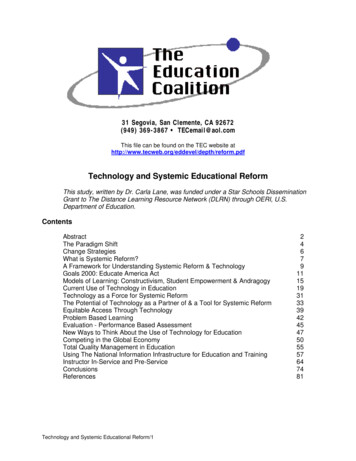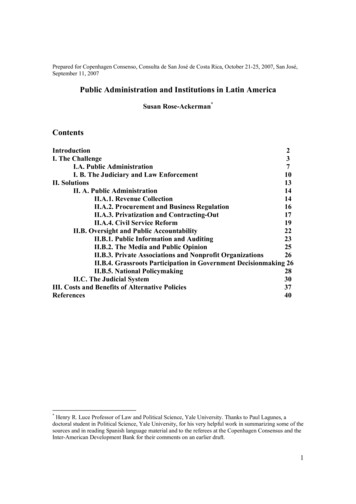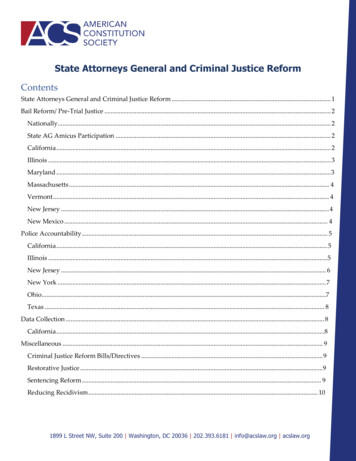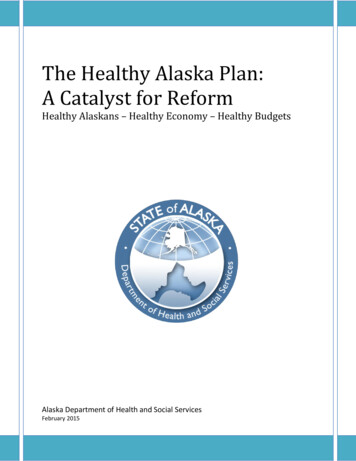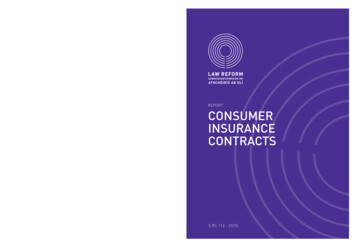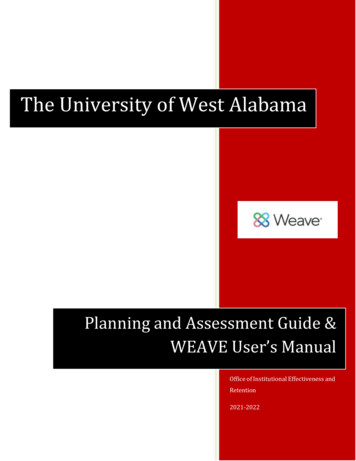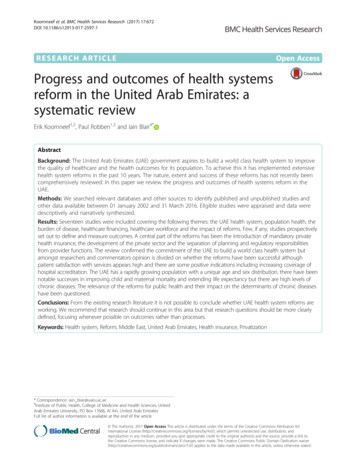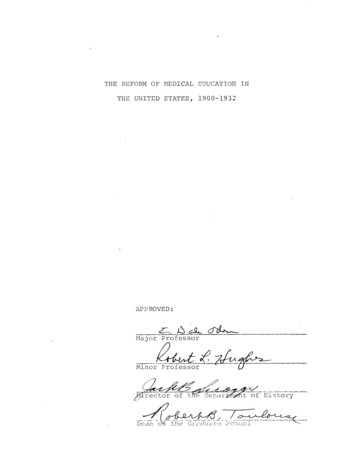
Transcription
THE REFORM OF MEDICAL EDUCATION INTHE UNITED STATES, 1900-1932APPROVED:A aJL cTlU—Major ProfessorMinor: Professor 0 r e c t o r of the Depariaffyarnt of History Q- iyDean oM the Graduate Scuool
McCarty, Robert L,, The Reform of Medica1 Education inthe United States , 1900-1932 . Master of A.rts (History)""December, 1971, 144 pp., bibliography, 114 titles.In 1900 the United States had more medical schools thanthe rest of the world combined.Many of them were commercialinstitutions devoted to making profits rather than to educating men to perform competently within the medical profession.The profit incentive precipitated low educational standardsand made American medical practice decidedly inferior tomedical practice almost anywhere else in the civilized world.By 1900 medical education had become pernicious, threateningthe health of the nation and the future of the Americanmedical profession.After fruitless efforts to reform medical educationearly in the nineteenth century, responsible medical educators and practitioners organized the American MedicalAssociation in 184 7 for the expressed purpose of improvingmedical schools.Yet the AMA reformed medical education butlittle before 1905.Commercialism continued unabated.Although a few improvements v/ere made between 1905 and 1908 ,reform stagnated and the AMA asked the Carnegie Foundatj.cn forthe Advancement of Teaching for assistance.Consenting, theCarnegie Foundation published Medical Education in the UnitedStates and Canada by Abraham Flexner in 1910.
Flexner condemned, commercialism for making a mockery ofmedical education.He blamed state governments, the medicalprofession, university administrators, and the public forthe despicable condition of most medical schools.Yet hisreport was more than a sordid description of sorry medicalschools.He developed a theoretical plan reformers coulduse in revamping medical education.With the impetus of The Flexner Report, commercialschools were destroyed between 1910 and 1920, while thoseremaining were improved through enforced educational standards, better teaching methods, laboratory construction, andthe acquisition of public and private money.By the FirstWorld War medical educators thought they were approachingscientific medical education, but the war demonstrated thatmany young doctors were incapable of practicing medicine.Many of them could not even administer an adequate physicalexamination.Although the causes for their inabilities werelegion, excessive external regulation of the curriculum wasthe primary one.Schools had to adhere to obsolete course requirements while at the same time trying to keep abreastof new scientific discoveries.Medical educators intensifiedcurriculum difficulties by emphasizing minute detail and rarediseases at the expense of general scientific principles andcommon illnesses.It was not until 1925 that schools were freed fromexcessive regulation so that they could develop flexible
educational programs.By 1932, although the depression hadits deleterious effects on medical schools, the reform movement achieved a goal reformers had set for medical educationyears before; that is, medical education, entering its finalstage of reform, was becoming a scientifically based university discipline.While the reform movement had its positiveand negative effects on medical schools in particular andAmerican education in general, it was an extremely successfuleffort by sincere men to make their profession worthy of itsresponsibilities.This study is based almost exclusively on primarysources.Medical educators and practitioners wrote almostall of them.N. P. Colweli, a medical educator, wrote allof the government documents dealing with medical educationfrom 1913 to 1929.It appears that the few non-medical menwho wrote on the subject did so by invitation; like theother writers, they were active participants in the reformmovement.With the exception of Medical Education in theUnited States Before the Civil War by William Norwood, amedical educator, no definitive history of medical educationhas been published.Therefore, views on the reform movementby men not involved in it are unavailable.
THE REFORM OF MEDICAL EDUCATION IK1THE UNITED STATES, 1900-1932THESISPresented to the Graduate Council of theNorth Texas State University in PartialFulfillment of the RequirementsFor the Degree ofMASTER OF ARTSBytobert L. McCartv, B. A.Denton, TexasDecember, i 37 x
CHAPTER ITHE PROBLEM OF MEDICAL EDUCATIONIN THE UNITED STATESIn 1705 Robert Beverley of Virginia observed that thePlanters were a blessed people:They have the Happiness to have very few Doctors,and those such as make use only of simple Remedies,of which their Woods afford great Plenty. And indeed, their Distempers are not mariy, and theirCures are so generally known that there is notMystery enough, to make a Trade of Physick there,as the Learned do in other countries, to the greatoppression of Mankind.1Unfortunately, this coald not be said of any Americansin 1910.On the contrary, their health was threatened byan over-abundance of inadequately trained medical practitioners who were incapable of combating ordinary diseaseand sickness.2Henry S. Pritchett, President of theCarnegie Foundation for the Advancement of Teaching, afterconsidering existing sanitary and health conditions, said in1910 that the United States needed only one doctor for everyiRobert Beverley quoted in Daniel J. Boors tin, TheAmericans: The Colonial Experience (New York, 1958), p. 210.2Abraham Flexner, Medical Education in the UnitedStates and Canada, A Report of the Carnegie FdunGatTon forthe Advancement of Teaching (New York, 1310). Hereinaftercited as The Flexner Report. The information here cited isfrom the Introduction"to The Flexner Report by Henry S.Pritchett, p. xx.
fifteen hundred people.In 190' there were 134,402 physi-cians in the United States which would provide one physicianfor every 56 8 people, alinest three c.imes the number neededto give the nation adequate medical care.Based upon onedoctor per one thousand of population, the United States hadtwice as many doctors as England, four times as many as3France, and five times as many as Germany.Although the over-supply of physicians caused members4of the profession serious economic losses,over- rowdingwas symptomatic of a far deeper and much more serious ailment.Abraham Flexner pinpointed the problem in his 1910report, Medical Education in the United States and Canada.Flexner believed that the United States was fortunate tohave some of the best doctors in the world, yet he knew ofno other place on earth where there was "so great a distanceand so fatal a difference between the best, the average, andthe worst."Flexner's point was that many American physi-cians were grossly ignorant of the human machine, of itsdiseases, and of modern scientific cures for them.Like Commission on Medical Education, Final Report of theCommission on Medical Education (New York, 19 32) , Appendix,Table 6CL Hereinafter cited as Final Report; Henry S.Pritchett, "The Obligations of the University to MedicalEducation," Journal of the American Medical Association,LIV (April 2, 1910), 1110. Frank Billings, "Medical Education in the UnitedStates," Journal of the American Medical Association, XL(May 9, 190 3), 1272. Flexner, The Flexner Report, p. 20,
Flexner, many members of the medical profession thoughtAmerican medical practice fell far bolow its potential.John H. Blackburn, for example, regarded as shameful thefact that in 1910 many medical schools still produceddoctors who were "not qualified to take into their care thelives of human beings . . . .For a number of reasons, Flexner, Blackburn, and manyothers blamed the poor quality of medical practice on thepoor quality of medical education.In 1908 Arthur DeanBevan, Chairman of the Committee on Medical Education of theAmerican Medical Association, after investigating thenation's medical schools on a very liberal basis, determinedthat of the 161 schools only 02 were acceptable while 47were of dubious value and 32 were entirely unsatisfactory.These 79 inferior schools, most of them commercial insti1tutxons, were causing the problems.'The commercial schools were not teaching the sciencesbasic to an understanding of a healthy human body, much lessa sick one.What they did teach was taught, with antiquatedmethods inappropriate to the subject matter.Some of theschools had no teaching equipment at all, or if they had6John H. Blackburn, "The Course of Postgraduate Studyof the American Medical Association," International Clinics,Twentieth Series, Vol. I (1910), 188."7Arthur Dean Bevan, "Medical Education in the UnitedStates: Need for Uniform Standards," Journal of the AmericanMedical Association, LI (August 15, I9C8), S u 7.
any, it was little and of such poor quality that it wasfruitless to embark on training wd t:ii it.In some casesbuildings were dilapidated fire-traps,- while in many othersscientific laboratories were non-existent.Many of thelaboratories in use were so inadequate and filthy ciheyhindered learning and endangered the health of teachers andstudents.Most of the commercial schools, depending solelyupon student fees for financing, had not yet accepted thefact that modern medical education was impossible to provideat a price students could pay.The inferior medical schools were not even supplyingtheir students with skills basic to an intellectual .pursuit.In 1904 James Winfield, a medical educator, stated thatmany physicians did not know how to use a medical library.What was worse, many doctors possessed little if anyappreciation for the library or for its essential functionin the practice of modern medicine. Winfield had alsonoticed that medical students were burdened to "well-nighfruitless effort" in their attempts to "glean anything fromthe enormous mass of medical literature . . ."10 which Lewellys F. Barker, "Medicine and the Universities,"American Medicine, IV (July 26, 1902), 143; Billings,"Medical Education in the United States," 1272; Flexner,The Flexner Report, pp. 6-7.9James Winfield, "The Medical Library as a Factor inMedical Education," Medical Library and Historical Journal,II (June 6, 1904), 183-185.l ibid., p. 183.
was available.Thus by producing doctors -who were unable topractice their profession competently ana who were unable toteach themselves, commercial medical schools endangered thehealth of the nation and seriously threatened the future ofthe American medical profession.In almost half thenation's medical schools, medical education had becomepernicious.By 1910 the destructive character of medical educationhad been evolving for over a century.Voices pleading forreform had been whispering all the while, and the firstdecade of the twentieth century proved to be climactic, forthe long festering sore finally came to a head.Sporadicspurts of reform preceded the publication of Flexner1s 1910report, Medical Education in the United States and Canada,but a virtual revolution followed it.By the turn of thecentury conscientious medical practitioners, deeply concerned for the future of their profession and with the11health of the nation, were fed up and angry.In 1903 an angry Frank Billings said, "In the earlierdays of our country . . . medical education wasprostituted."12Seven years later, W. C. Borden, being lessemotional and more analytical, observed that medicaleducation had "had a somewhat peculiar history, a history Billings, "Medical Education in the United States,"1271-1272.l ibid., p. 1271.
showing an intermingling of high ideals and great aspirationswith the lower motives of opportunism and commercialism.1'" Borden's statement clearly describes the development ofAmerican medical education to that time.That medical education was prostituted cannot be easilydenied.Yet its beginnings, although short-sighted, wereambitious and hopeful.Nowhere in the world was eighteenthcentury medical practice or medical education based on purescience.Much of it was flagrant superstition.Even so,formal medical education in the United States began as auniversity discipline.For Flexner, the importance of thisfact could not be overemphasized.He argued persuasivelythat getting away from the university proved detrimental tomedical education, to the medical profession, and, ultimately,to the people.For good reasons, Flexner believed thatmedical education, had it remained an integral part of theuniversities where it originated, would have improved alongwith them.- However, before medical education moved into the university, physicians received their training from preceptors.The preceptorial system, William F. Norwood writes inl wiHiam C* Borden, "The Trend of Medical Education inthe United States," New York Medical Journal, XCII (July 2,1910),1.l Erwin H. Ackerknecht, A Short History of Medicine(New York, 1955) , pp. 204-207; Borden" "The" Trend of MedicalEducation in m e Onitea States," 1; r'iexuer, The FlexnerReport, pp. 4, 6, 20.
Medical Education in the Limited Sbates Before the Civil War,"was not only well adapted to the unpolished state ofsociety but was to some extent a product of the wildernessculture." Necessary, useful, and practical, the precep-torial system was typically American.supplied most of the nation's doctors.For many years itIt has been esti-mated that in 177 5, a decade after the first medical schoolopened, only four hundred of the nation's thirty-fivehundred physicians were university trained; the vast majority of those holding degrees earned them in Europe.Sincemost Americans aspiring to a medical profession could notafford an European education, they had to settle fora preceptor."'" Each preceptor decided for himself what preliminaryeducation suited a man for a physician's training.Gener-ally, however, the students had to possess some knowledgeof classical languages, particularly Latin.They, had to becompetent in mathematics and English grammar, and a17familiarity with natural history was beneficial.As willbe seen shortly, these requirements were vastly superior to William F. Norwood, Medical Education in the UnitedStates Before the Civil War (Philadelphia, 1944), p. 37.Hereinafter cited as Civil War.l Ackerknecht, A Short HistoryMedicine, pp. 204205. The preceptorial system was a reversion to ancientGreek and Indian methods of medical education. Norwood, Civil War, pp. 32-33.
8those of many medical schools in the. first decade of thetwentieth century.Flexner thought the preceptorial system was well suitedto the training of physicians.The very nature of thetraining, involving the students in the life and deathstruggle immediately, let students experience the joys andsorrows of medical practice.Immediate, practical, intense— preceptorial training was the best kind of education; andreturning the student to the patient became one of the18primary goals of the reform movement.Like Flexner, Norwood thought the preceptorial systemwas a practical teaching method suited to the times.But hewas more willing to admit that the system had serious flaws:The chief virtue of the preceptorial system wasthat the students so trained were not inclined to bemere theorists. The practical clinical experienceand observation which most students had from thefirst, though too often they were ill-prepared toappreciate what they saw, built into the Americanmedical profession that spirit of self confidence andpracticality which has characterized it down bo thepresent time.19The preceptorial system, by failing to prepare studentsfor their learning experiences, failed to achieve, much lessmaintain, a pinnacle of quality better medical practitionersexpected.Moreover, since there were no generally acceptedor enforced rules or regulations on the training of doctors,Flexner, The Flexner Report, p. 20.19Norwood, Civil War, pp. 36-37.Italics mine.
instruction varied greatly from preceptor to preceptor.Some of the preceptors were demanding, efficient, and responsible while others misused their students, putting them towork at menial, non-medical chores like greasing buggywheels and currying horses.Time could have been better20spent reading.The preceptorial system undoubtedly trained betterdoctors at its inception than it did in later years.Mostof the original preceptors had had some schooling beforeemigrating from their homelands.They tried to pass theirschooling on to their students; but the new doctors, entering actively into the'profession, took on students themselves;and training slowly but surely deteriorated.The systematicand comprehensive demands associated with educational institutions were missing.As deterioration became more and moreprevalent, members of the profession who objected joinedforces and asked their fellow physicians to refuse studentsunless they could be provided with an ample supply of books,diagrams, clinical experience, and other paraphernaliadeemed essential in providing sound medical knowledge.Many21doctors ignored the request.Attempts to supplement and improve upon preceptorialtraining were initiated as early as 17 50, when classes inanatomy were offered. In 1762 William Shippen, who had Jbid., pp. 32, 38-39. Ibid., pp. 32-39.
10been educated at Edinburg, lectured on midwifery, hoping toshare some of his European training with physicians lessfortunate than himself.Flexner maintained that the firstmedical school in the colonies grew out of these lectures.According to Flexner, Shippen and John Morgan, also educatedat Edinburg, opened the Philadelphia Medical School in 176522under the auspices of the University of Philadelphia.Norwood, in his more detailed history of early Americanmedical education, presents a much different story.and Shippen were both reared in Philadelphia.MorganShippen, alittle older, was completing his medical course just asMorgan was beginning his.The two probably got together atEdinburg and talked about organizing a school back home.For reasons unknown, however, friendship waned and planswere interrupted.But Morgan went on with the plans alone.Winning the confidence of the trustees of the University ofPhiladelphia, Morgan was permitted to organize a medicaldepartment there in 1765.After the school had been started,Shippen claimed the idea for the school was originally his.Be that as it may, Norwood gives Morgan credit for organizing23the first medical school in the colonies. Flexner,The Flexner Report, p. 3. N o r w o o d , Civil War, pp. 4-6; There is much conflicting opinion on this point. F. R. Packard supports Shippenin F. R. Packard, "Early Methods of Medical Education inNorth America," Journal of the American Medical Association,XXXII (January 12,- 1899), 636, yet Ackerknecht, A ShortHistory of Medicine, pp. 204-207, supports Morgan.
11In May, 1765, Morgan, energetic, intelligent, andinspired, spoke at the commencement exercises of theUniversity of Philadelphia.His subject was reforming themedical profession in the colonies through improved medicaleducation.Morgan stated frankly that a doctor without aformal education was dangerous because he possessed toolimited a knowledge of medicine to be responsible for humanlife.Emphasizing the importance of appropriate pre-medicaleducation, Morgan outlined a course of medical study thatincluded a systematic classification of medical branches tobe studied.While describing the condition of medical prac-tice in the colonies,' he gave convincing arguments for theneed of a medical school.He outlined the advantages theuniversity could expect from such a department and concludedby asking that prospective medical students be counseledbefore they entered their training to determine their qualifications, interests, and motives.On May 3, 1765, thetrustees elected Morgan the first Professor of the Theory24and Practice of Medicine in British North America.At Philadelphia Morgan established many precedents towhich twentieth century reformers looked for support.Ofparticular importance were those concerning entrance anddegree requirements.A student had to apprentice himself toa reputable physician.If the student held no degree, hehad to satisfactorily demonstrate to the trustees and the Norwood, Civil War, pp. 2-7
12professors that his abilities in Latin, mathematics, andnatural and experimental philosophy indicated the possibility of his completing the medical course; successfully.Requirements for the Bachelor of Medicine degree werestrenuous.Besides preceptorial training, they included atleast one course of lectures in anatomy, chemistry, materiamedica, and the theory and practice of medicine.This wasfollowed by a course of clinical lectures and one year ofpractice at the Pennsylvania Hospital, the best hospital inthe colonies.In all, a three-year course, exclusive of pre-ceptorial training, was organized.After completing thecourse, the student was required to pass examinations.Eventhen, however, he received his degree only if the trusteesand the professors were satisfied with his work.The Doctorof Medicine degree required three years of study beyond theBachelor's degree.The candidate had to be at least twenty-four years old and had to publicly defend his thesis, writtenin Latin.The thesis had to be published.Unfortunately, these requirements were short-lived.Unprofessional quarrels between faculty members, involvementin the politics of the American Revolution, and the inabilityof the university to attract doctors to take the higherdegree precipitated a lowering of standards.The school didaway with the Bachelor of Medicine degree and, except for Ibid. , pp. 65-66.
13natural and experimental philosophy, all of its preliminaryeducation requirements.The required course, shortened fromthree to two years, could be satisfied simply by repeatingeach subject area lecture in the second year.The schoolretained apprenticeship but dropped the hospital year completely.A thesis in English or Latin was acceptable.Thestudent, after completing this watered-down course, received*? fithe degree, Doctor of Medicine.Harvard, Yale, and.King's College followed the exampleof the University of Philadelphia in organizing medical77departments.But "American medical education was yet inits cradle," for many'of the degrees conferred were28honorary.Norwood summed up eighteenth century medicaleducation:The eighteenth century, with reference to medicaleducation in the colonies and the young republic, wasa period of orientation. A race of pioneers, devotedto the building of a nation, practiced the arts ofstatesmanship and theology but left the art of healingto Providence and practitioners, many of whom were illtrained. Legislators gave transitory attention toregulation and protection of the profession. Organizededucation took no cognizance of medicine as a branch oflearning. Practitioners trained apprentices. Each preceptor produced, after his kind, fledglings in the artof physic. Few were equipped to act as master. Throughthe agency of European-trained physicians and the writings of their masters, the profession in America emergedfrom fallow years. Lecture courses in midwifery andanatomy were given, dissections were made, hospitals Ibid. , pp. 67-68. Flexner, The Flexner Report, pp. 4-5. Norwood, Civil War, p. 60.
14were started. The profession served admirably throughseven years of bloodshed and gathered from the experience scientific improvement and professionalconsciousness. Medicine was moving forward, butorganized instruction was yet in its formative years.Schools were few and poorly equipped. Attendance, onthe whole, was small. The practitioners office wasstill the school of medicine.29Looking to the origins of medical education in theeighteenth century to find support for arguments against themedical schools of his own day, Flexner regretted that the"sound start of these early schools was not long maintained.Their scholarly ideals," he wrote, "were soon compromisedand then forgotten." 0But Flexner, less inclined thanNorwood to accept the lowering of standards at Philadelphiaas the inauguration of decline in American medical education, blamed degeneration on the University of Maryland andher establishment of a commercial medical school in 1812.Both Flexner and Norwood considered chartering the Marylandschool a tragedy because it tried to make a medical schoolthe nucleus for the entire university, grafting schools oflaw and theology onto it.The university was proprietary innature and there was no central governing body.Since theprofessors ruled the university, they could maintain theirpositions indefinitely.But regardless of how commercialmedical schools got their start or how well some few of themserved the medical profession, in the view of twentieth29ibid., p. 62,30Flexner,TheFlexnerReport, p. 5.
15century reformers commercial, medical education was a cancerous growth.Commercial medical schools gave birth to allthat was pernicious and corrupt in medical education and in 5 1the medical profession.Although commercial- schools rose and fell constantly,after 1812 the number multiplied disgracefully.Norwoodmade the following observation:Schools sprang up like mushrooms in coastal cities, ininterior valleys' of the Piedmont, and in the expansivetrans-Appalachian area from Michigan and Wisconsin toAlabama and Louisiana. Under the impetus of far-westernexpansion the movement reached the pacific coast in 185 8with the establishment in San Francisco of the Universityof the Pacific.32In 1810 there were five medical schools.later the number had doubled.A decadeAnother decade saw the numberdouble again as an average of one new school was organizedeach year.In 1850 there were fifty-two schools, and by theoutbreak of the Civil War the number had reached sixty-five.Although twenty schools failed to survive the war, therewere one hundred medical schools in 1880.there were thirty-three more.attained in 1906.Ten years laterThe largest number, 161, wasThereafter the number declined slowlyuntil the publication of the Flexner Report in 1910 precipitated many closures throughout the United States.Apparently31ib.id. ; Norwood, Civil War, pp. 240-241; Billings,"Medical Education in the United States," 1271-1276; Flexner,The Flexner Report, Pritchett's Introduction, p. x.- Norwood, Civil War, p. 429.
16several school administrators saw the coming fury.At anyrate, there were 131 schools doing business at the close of1910.33Although many of these schools were nominally affiliated with established and oftentimes highly respecteduniversities, most of them were commercial institutions.The universities supplied little more than their names, providing neither administrative nor financial support.Henry S. Pritchett and Lewellys F. Barker, to name only two,reprimanded the universities for their disastrous dereliction of duty.3 An irate Abraham'Flexner described the expansion ofmedical schools thusly:These enterprizes—for the most part they can be calledschools or institutions only by courtesy- were fre— quently set up regardless of opportunity or need: i n small towns as readily as large, and at times almost mthe heart of the wilderness.35Whenever a handful of practitioners without school affiliations got together, the likelihood of a new school emergingwas great.33A school needed only a faculty to open.Ibid.,United StatesConnectlcuttTFinal Report,Thepp. 139-140; The Statistical History of thefrom Colonial Times to the Present (Stamford,1965), p. 34; Commission on Medical Education,Appendix, Table 104.34piexner, The Flexner Report, p. 8; Bevan, "Medical Education in the"United States: Need for Uniform Standards,566- Pritchett, "The Obligations of the University toMedical Education," 1110; Barker, "Medicine and theUniversities," 147.35Flexner, The Flexner Report, p. 6.
17faculty did not have to be a good one, just one composed ofmen who were willing to teach in filthy, badly lightedbuildings without books, laboratories, or clinics.Commercial medical education expanded rapidly for anumber of reasons, chief among them being the failure ofstate legislatures to accept their responsibility of controlling it.In some cases they were unable to do so.Forexample, in New York before the Civil War, the Regents ofthe University of the State of New York were delegatedsupervisory powers over chartered institutions.The Regents,however, found it impossible to control the spread ofcommercial medical schools in their state, primarily becausestate medical societies, by lying about the quality of education the schools offered, encouraged and perpetuated theiro7contagion."It is clear . . . " Norwood wrote, "that nouniform system of establishing or governing medical schoolsOOexisted at the time."This was true all over the Country.Rather than enact legislation aimed at controlling theorganization of medical schools, state governments tried toregulate the practice of medicine.This, of course, onlyindirectly affected medical education.Laws with the inten-tion of eliminating quackery were passed in the second half Ibid., pp. 6-7.37jsiorwood, Civil War, p. 385.33lbid.
18of the eighteenth century.Ultimately, state medicalsocieties were entrusted with licensing powers, and theybecame responsible for medical education when they acceptedthe Doctor of Medicine degree as sufficient proof of medicalknowledge.Any man possessing a degree from a "recognized"school could practice medicine in any state without furtherproof of knowledge or ability.Even without a degree,candidates were licensed if they passed an examination thatsatisfied the medical societies.But these restrictionswere nullified considerably when all but four states repealed39their medical practice acts after 1842.By 1888 the American Medical Association was demandingeffective state legislation to protect the public and themedical profession from quackery in all its forms whetherpsuedo-scientific or religious.It was, responsible physi-cians argued, the right and the duty of the stat
That medical education was prostituted cannot be easily denied. Yet its beginnings, although short-sighted, were ambitious and hopeful. Nowhere in the world was eighteenth century medical practice or medical education based on pure science. Much of it was flagrant superstition. Even so, formal medical education in the United States began as a



